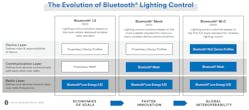In September 2023, the Bluetooth Special Interest Group (SIG) launched Bluetooth NLC, specifications defining roles and responsibilities for common lighting control devices installed in a Bluetooth wireless network.
Bluetooth NLC builds on prior Bluetooth Low Energy (LE) and Bluetooth Mesh wireless standards to provide full-stack standardization for how devices communicate and operate within a wireless mesh network.
By enabling true multivendor interoperability across the control system, the Bluetooth SIG claims Bluetooth NLC will promote mass adoption of wireless networked lighting control systems in nonresidential buildings.
Wireless lighting control
Networked lighting control systems are intelligent systems in which devices connect to enact control strategies to save energy and enhance flexibility. Average lighting energy savings of nearly 50% are achievable, according to research conducted by the DesignLights Consortium (DLC). Networked lighting control systems facilitate integration with other building systems as well as value-added services like space optimization, indoor wayfinding, and asset tracking.
Despite the utility of networked lighting control systems, adoption has been inhibited by a lack of standardization and interoperability, according to the DLC and Bluetooth SIG. Bluetooth NLC was designed with that issue in mind.
Generally, the lighting network is formed by control signal/data communication pathways implemented as dedicated low-voltage control wiring, a dedicated wireless radio frequency, or a solution integrating both approaches. Each approach has its particular advantages. Advantages of wireless implementation include flexibility in placing and relocating certain devices, economized installation labor, and a less physically intrusive installation within the space. This makes wireless well suited to existing buildings, especially in spaces where installing control wiring would be costly or prohibitive.
A wireless lighting control solution typically consists of three layers. The radio layer defines how devices send data. The communication layer defines how devices communicate. The device layer defines roles and responsibilities for each device network node, also called the edge devices. Each layer may be governed by a standard or proprietary technology.
Various topologies may be deployed for the solution’s architecture; a mesh topology is one of the most frequently used. In this topology, devices communicate with each other as nodes in a network; a signal generated by one device is routed in the most efficient path through others until it reaches its target. Mesh networks also are self-healing — if a node fails, the signal will be routed through other devices.
In 2010, the Bluetooth SIG released Bluetooth Low Energy (LE) for the radio layer. In 2017, it released Bluetooth Mesh for the communication layer. With the release of Bluetooth NLC in 2023, Bluetooth became a full-stack standard for wireless mesh-networked lighting control, enabling multivendor interoperability.
What’s in Bluetooth NLC
Again, Bluetooth NLC takes Bluetooth standardization to the edge device layer. The initial round of specifications covers six common device roles, including Occupancy Sensor (occupancy sensing), Ambient Light Sensor (light level sensing), Energy Monitor (energy data reporting), Scene Selector (wall switch/station for On/Off and/or lighting scenes), Dimming Control (dimmer), and Lightness Controller (luminaire with an integrated controller).
Bluetooth NLC allows the use of any complying manufacturer’s device interchangeably; that is, the device would exhibit the same behavior and level of interoperability. For example, every occupancy sensor in a Bluetooth NLC network would behave in exactly the same way regardless of which company manufactured it.
A single device may combine multiple control roles, such as an occupancy sensor with a DALI/D4i port. This device may be designed to serve as Occupancy Sensor, Ambient Light Sensor, and Lightness Controller. An Energy Monitoring role may also be provided by this device, with energy data produced by the D4i LED drivers aggregated and forwarded over the mesh network.
Benefits of Bluetooth NLC
The Bluetooth SIG states that benefits of Bluetooth NLC include multivendor interoperability, enhanced ease of deployment, and enhanced scalability.
Because device roles are standardized, manufacturers can focus on value-added features, combining roles in the same hardware, data applications, and building a superior system interface. The considerable number of manufacturers working with Bluetooth suggests Bluetooth NLC-qualified product development may be significant and swift.
Because of their familiarity with Bluetooth, designers can specify solutions based on system functionalities and the space requirements. This means that products from one or more manufacturers may be selected to provide the most desirable combination of cost, functional features, system interface, technical support, and security features that cover the product lifecycle, from manufacturing to disposal.
Contractors can rely on user-friendly interfaces to guide them through network configuration and setup. Because Bluetooth NLC-qualified devices are fully discoverable using any device with a Bluetooth connection, a phone app could directly query devices on the network to learn what they are and their characteristics, regardless of manufacturer.
After discovery, these devices could be assigned to sequences of operation to satisfy the project requirements for the space. A remote provisioning feature would allow this configuration and later reconfiguration to occur without being physically onsite.
Following installation, Bluetooth NLC’s decentralized architecture supports expansion based on changing needs. This facilitates scalability, including the ability to realize the control solution over time, which is an approach well-suited to existing buildings. The decentralized architecture also combines with other benefits for small and midsized buildings in addition to larger buildings that are more commonly the province of networked control.
Game changer?
In many industries, standardization has played a critical role in mass adoption. Staying current with standards and compliant product launches is key for lighting professionals. As wireless lighting controls continue to grow in popularity, Bluetooth NLC offers a path to interoperability that may accelerate adoption of networked lighting controls in both new construction and existing buildings.
Learn more about Bluetooth NLC at Bluetooth.com.
Bluetooth is a registered trademark of Bluetooth Special Interest Group. “Networked lighting control(s)” is spelled out to distinguish between the Bluetooth NLC standard and the general controls term.
CRAIG DILOUIE is education director for the Lighting Controls Association, a council of the National Electrical Manufacturers Association that educates the public about lighting control technology and application.
Follow our LinkedIn page for our latest news updates, contributed articles, and commentary, and our Facebook page for events announcements and more. You can also find us on the X platform.








